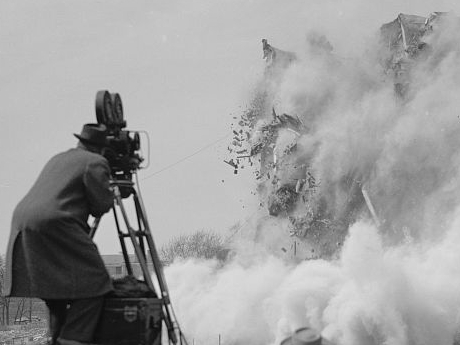

Beginning with a compelling, action-packed image from the Library of Congress’ “Mystery Photos” series, I wanted to see what I could create by further removing context. The image was originally published in this collection because its origin and historical context was unknown by preservationists. After some internet sleuthing, users determined that the image was taken in 1940 during the demolition of an apartment to secure the site of the future War Department Building in Washington DC.
For the purposes of this exercise, I’ve opted to eschew the context uncovered by users in favor of telling a new story through cropping. Removing the swarm of onlookers and second camera operator, I’ve highlighted a single figure as the new focal point. The new image is cropped tightly, creating a sense of intimacy and more immediate danger between the camera operator and the destruction in the distance, which is increasingly foregrounded through the cropping.
In the new image, viewers might imagine the figure as the sole witness of the destruction. Is he far enough away to stay safe? Taking it a step further, reducing the image to a single onlooker creates a sense of cause and effect. To what degree is the figure responsible for the destruction? They don’t call it shooting footage for nothing…
*Full Library of Congress title: Apartment building blasted to make room for War Department building. Washington D.C. Mar 20–what looks to be a photo from Europe is in reality a photograph taken in Washington this morning when a 9-story building was blasted down to make room for the new $4,300,000 war department building. The blast was so neatly placed in the concrete and steel building that it gently folded up like an accordion and collapsed. Photo shows movie photographers as they filmed the scene
Former title: Motion picture cameramen filming on top of cars, the demolition of the Boulevard Apartments at 2121 New York Ave. NW, Washington, D.C.


Hi Craig,
The photo you selected is quite fascinating. I do believe that the cropping of the image significantly changes its meaning. I appreciate the new narrative you’ve created – removing the onlookers and the second cameraman to leave a single cameraman filming, possibly as the sole witness to the destruction.
I wonder what story it would have told if only the onlookers were cropped, leaving just the two cameramen and the scene of destruction, including the building. This could have potentially conveyed the story of two lone cameramen trying to make it in Hollywood.
Overall, I think you did a great job cropping the photo. The cropping has revealed so much more detail. I can see a line running from the camera to the damage. I also notice a chest that the cameraman is kneeling on, perhaps to carry supplies or maybe his lunch.
Hi Craig! The photo that you picked for this assignment is so powerful and tells such a story. From afar, it is apparent that there is a crowd of people watching the destruction occur and the picture is full of noise. Once cropped, it looks like a one-man show and you would never know that there were other people also witnessing the explosion. I also have to give you credit for your clever title, I love how you played with the double meaning there. I think that you could have chosen to focus on the other person recording and it would’ve given a slightly different interpretation because you could see more of the standing building. Overall great job and I don’t have any suggestions!
Hi Craig,
The cropped image puts a focus on the destruction and the cameraman on the left. The cropped image reminds me of the old Hollywood movie effects and the cameraman. I would be interested to see what it would look like if you cropped out the left cameraman. This perspective is aesthetically pleasing to the viewer. Great use of the rule of thirds, Craig!